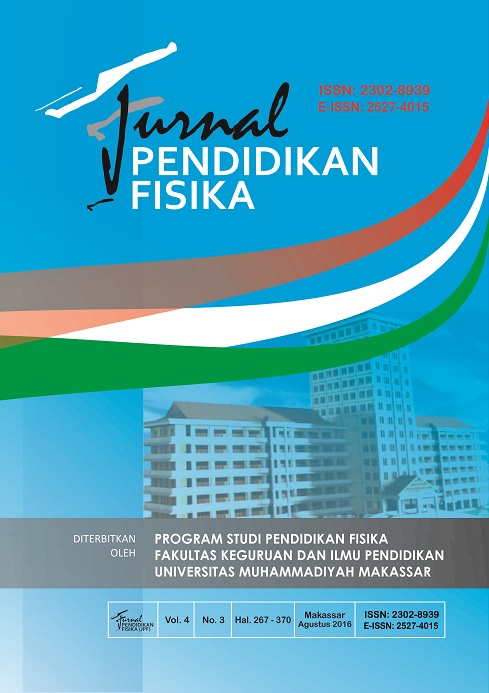Penerapan Strategi Prediction Guide Terhadap Hasil Belajar IPA Fisika Pada Peserta Didik Kelas VIII SMP Negeri 13 Makassar
DOI:
https://doi.org/10.26618/jpf.v4i3.335Abstract
Jenis penelitian ini adalah Pra-Eksperimen yang dilaksanakan di SMP Negeri 13 Makassar, penelitian ini bertujuan untuk meningkatkan hasil belajar IPA Fisika melalui strategi pembelajaran Prediction Guide. Subjek penelitian ini adalah pesertadidik kelas VIII SMP Negeri 13 Makassar sebanyak 32 pesertadidik. Pengambilan data dilakukan dengan menggunakan tes awal dan tes akhir, lembar observasi, instrumen penelitian dibuat oleh penulis. Data yang dikumpul dianalisis dengan menggunakan teknik analisis statistik deskriptif. Hasil penelitian menunjukkan bahwa skor rata-rata pesertadidik pada pre-tes sebesar 10,97% dan berada pada kategori rendah, dengan standar deviasi 2,87 sedangkan pada posttes diperoleh skor rata-rata sebesar 16,96% berada pada kategori tinggi dengan standar deviasi 2,55. Hal ini menunjukkan bahwa telah tercapai hasil belajar pesertadidik berdasarkan Kriteria Ketuntasan Minimal (KKM) yang ditetapkan sekolah yaitu 75,00, di mana pada pre-tes dari 32 pesertadidik terdapat 16 pesertadidik atau 64% yang tuntas belajarnya dan terdapat 9 pesertadidik atau 36% yang tidak tuntas belajarnya. Sedangkan pada posttes dari 25 pesertadidik terdapat 19 orang atau 76% yang tuntas belajarnya dan terdapat 6 pesertadidik atau 24% yang tidak tuntas belajarnya. Dari hasil penelitian ini dapat disimpulkan bahwa dengan diterapkannya pembelajaran dengan strategi pembelajaran Prediction Guide pada pesertadidik kelas VIII SMP Negeri 13 Makassar, maka hasil belajar IPA Fisika dapat meningkat.
Kata kunci: Prediction Guide, Hasil Belajar IPA, Peserta Didik
This research is a Pre-Experiments were carried out in SMP Negeri 13 Makassar, this study aims to improve learning outcomes Physical science through learning strategies Prediction Guide. The subjects were pesertadidik class VIII SMPN 13 Makassar much as 32 pesertadidik. Data were collected using the initial test and final test, observation sheets, research instruments created by the author. The data collected were analyzed using descriptive statistical analysis techniques. The results showed that the average score pesertadidik on a pre-test of 10.97% and are in the low category, with a standard deviation of 2.87, while the posttes obtained an average score of 16.96% at high category with a standard deviation 2.55. This shows that learning outcomes have been achieved pesertadidik based Complete Minimal Criteria (KKM) established in schools, 75.00, where the pre-test of 32 pesertadidik pesertadidik there are 16 or 64% who completed his study and there are 9 pesertadidik or 36% were not complete her studies. While on posttes of 25 pesertadidik there are 19 people or 76% who completed his study and there are 6 pesertadidik or 24% who did not complete her studies. From these results it can be concluded that with the implementation of learning with learning strategies Prediction Guide on pesertadidik class VIII SMPN 13 Makassar, the result of Physics Science learning can be improved.
Key Words: Prediction Guide, Science Learning Outcomes, Students
References
Ali Muhammad. 2010. Guru Dalam Proses Belajar Mengajar. Bandung : Sinar Baru Algasindo
Arikunto Suharsimi. 2006. Prosedur Penelitian Suatu Pendekatan Praktik. Jakarta: PT Rineka Cipta
Aunurrahman. 2009. Belajar dan Pembelajaran. Bandung : Alfabeta CV
Dalyono M, 2009. Psikologi Pendidikan. Jakarta : Rineka Cipta
Diknas, 2010. Bahan Penelitian Penguatan Metodologi Pembelajaran Berdasarkan Nilai-nilai Budaya untuk Membentuk Daya Saing dan Karakter Bangsa,
Hamalik O. 2010. Psikologi Belajar dan Mengajar. Bandung : Sinar Baru Algensindi
Karim Saeful, Karniati Ida, dkk. 2008. Belajar IPA:Membuka Cakrawala Alam Sekitar 2 Untuk Kelas VIII/SMP/MTs. Jakarta : Pusat perbukuan, Departemen Pendidikan Nasional.
Khaeruddin, dan Akib, Erwin. 2006. Metodologi Penelitian. Makassar. Lembaga Perpustakaan dan Penerbitan Universitas Muhammadiyah Makassar.
Koes H,S. 2003. Strategi Pembelajaran Fisika. Malang : JICA
Ridwan. 2004. Belajar Mudah Penelitian Untuk Guru-Karyawan dan Peneliti Pemula. Bandung : Alfabeta.
Sudjana. 1992. Dasar-dasar Statistik. Yogyakarta : Pustaka Insan Madani.
Sugiono. 2009. Teknik Pengumpulan Data. Yogyakarta : Pustaka Insan Madani.
Suprojono A. 2009. Teori dan Aplikasi Paike. Yogyakarta : Pustaka Belajar.
Winataputra, Udin, dkk. 1997. Strategi Belajar Mengajar. Jakarta : Universitas Terbuka.
Zaini Hisyam, Munthe B, dkk. 2008. Strategi Pembelajaran Aktif. Yogyakarta : Pustaka Insan Madani.
Downloads
Published
Issue
Section
License
Copyright:
Authors who publish with this journal agree to the following terms:
1. Authors retain copyright and grant the journal right of first publication with the work simultaneously licensed under a Creative Commons Attribution-ShareAlike 4.0 International License that allows others to share the work with an acknowledgement of the work's authorship and initial publication in this journal.
2. Authors are able to enter into separate, additional contractual arrangements for the non-exclusive distribution of the journal's published version of the work (e.g., post it to an institutional repository or publish it in a book), with an acknowledgement of its initial publication in this journal.
3. Authors are permitted and encouraged to post their work online (e.g., in institutional repositories or on their website) prior to and during the submission process, as it can lead to productive exchanges, as well as earlier and greater citation of published work.
Licence:
Authors are free to:
1. Share: Copy and redistribute the material in any medium or format
2. Adapt: Remix, transform, and build upon the material for any purpose, even commercially.
The licensor cannot revoke these freedoms as long as the authors follow the license terms, which include the following:
1. Attribution: You must give appropriate credit, provide a link to the license, and indicate if changes were made. You may do so in any reasonable manner, but not in any way that suggests the licensor endorses you or your use.
2. ShareAlike: If you remix, transform, or build upon the material, you must distribute your contributions under the same license as the original.
3. No additional restrictions: You may not apply legal terms or technological measures that legally restrict others from doing anything the license permits.
Jurnal Pendidikan Fisika is licensed under a Creative Commons Attribution-ShareAlike 4.0 International License.

